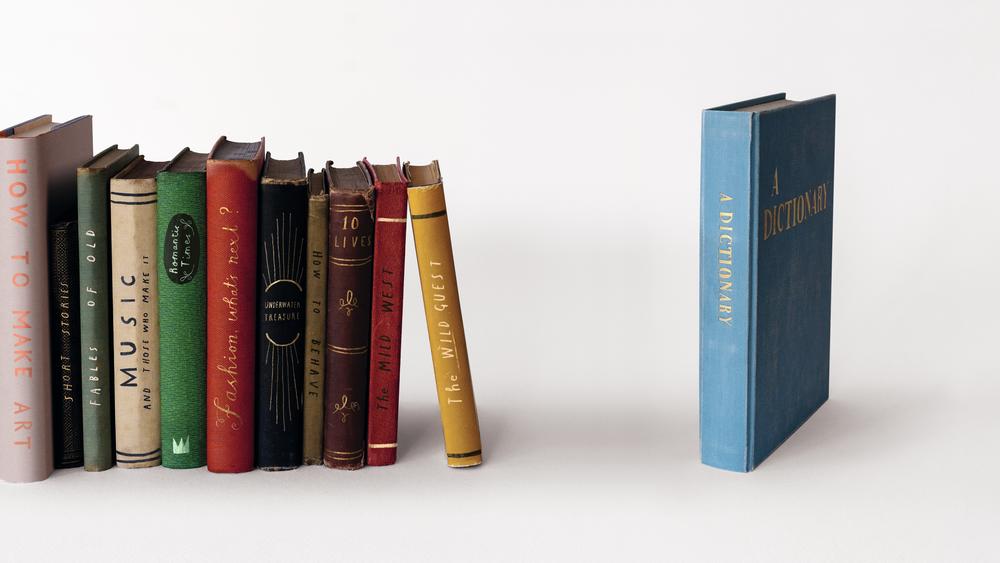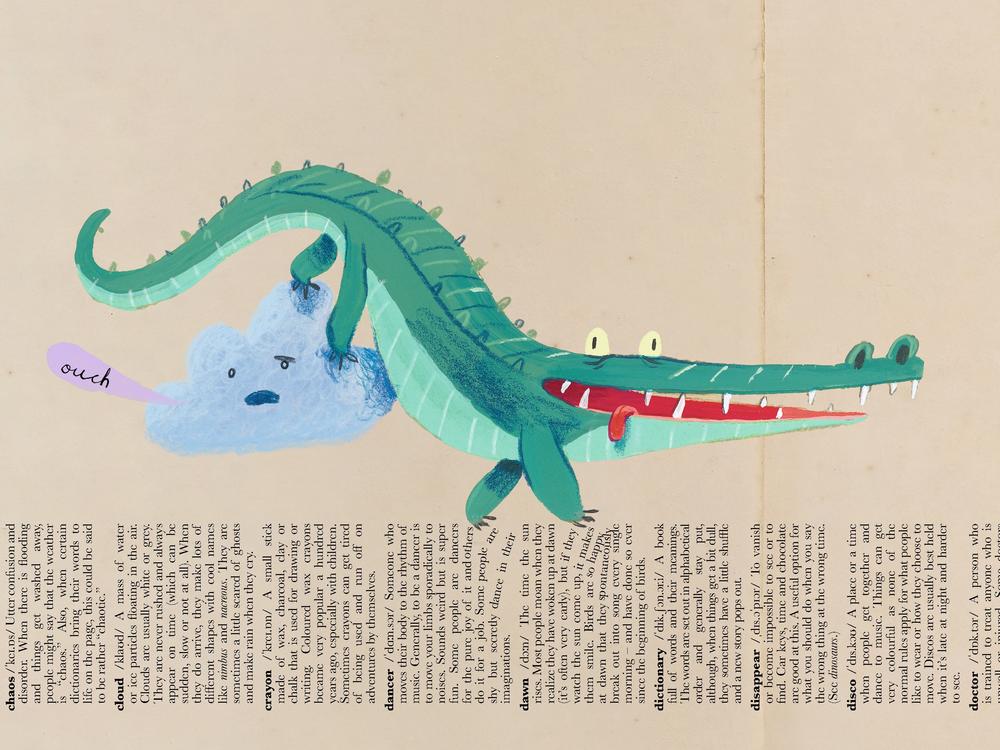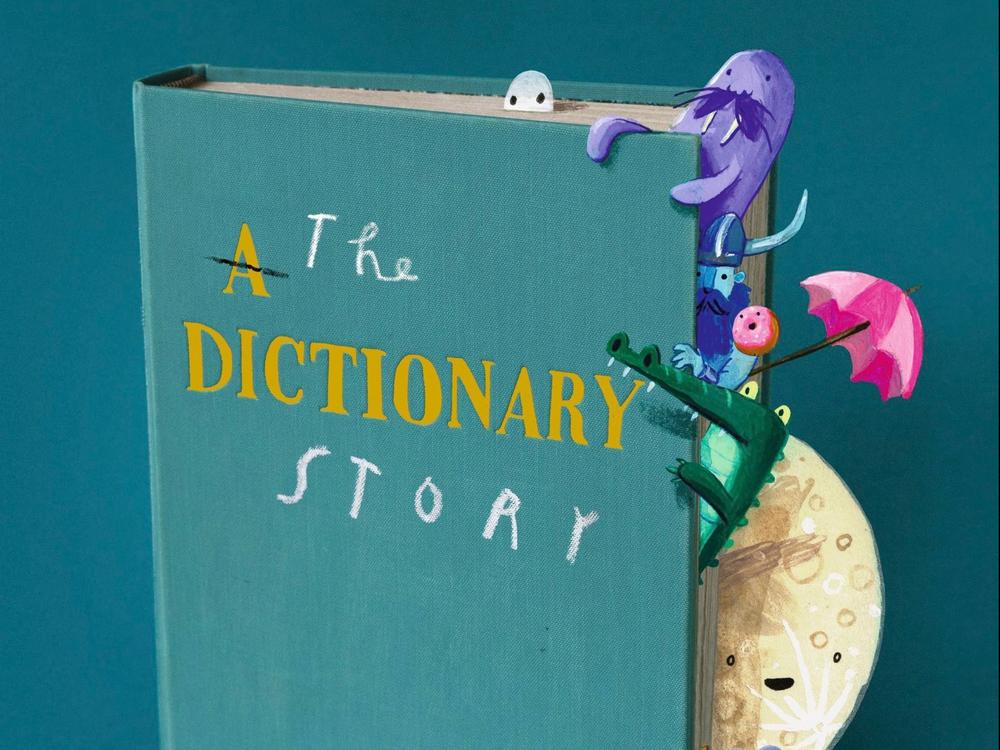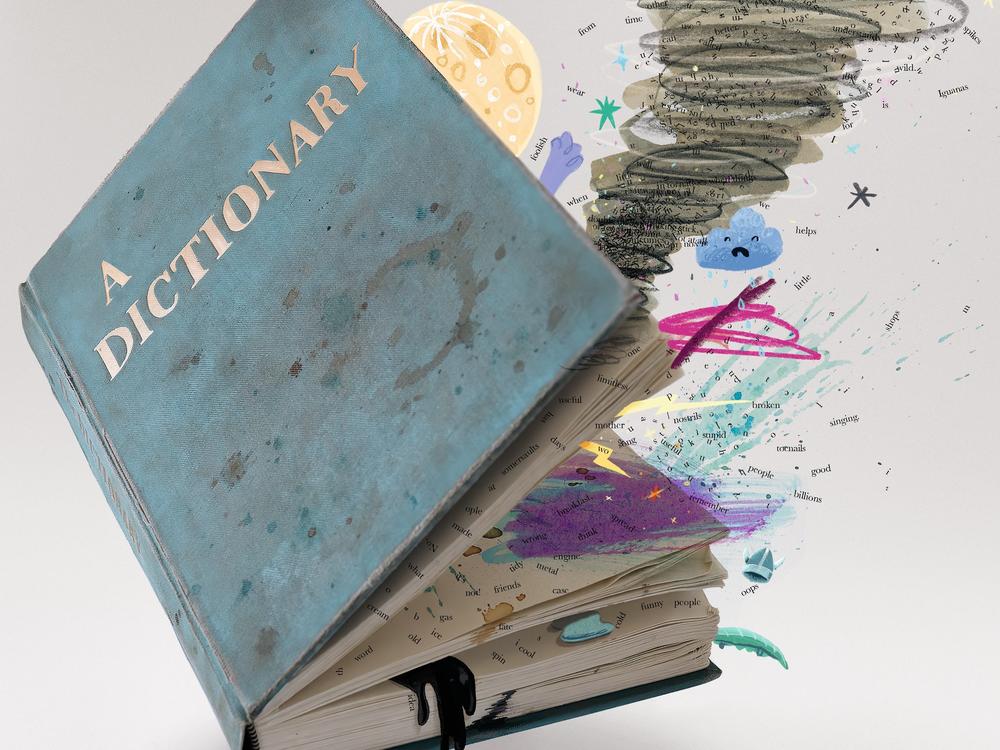Section Branding
Header Content
'The Dictionary Story' is a kids' book that defies definition
Primary Content
Have you ever read a children's book where the main character is… the book?
Dictionary has noticed that even though her pages contain all the words that exist, she doesn’t really tell a story like all the other books on the shelf do. So one day, Dictionary decides to change that and bring her contents — guts? pages? definitions? — to life.
A hungry alligator bursts out of the pages ready for a snack — and finds a donut several pages later. But Donut doesn’t particularly want to be eaten, so he rolls off further into the alphabet. Alligator gives chase and the story soon goes off the rails — they crash into Queen who slips on Soap. And that’s all before Tornado shows up! Definitions go flying, no one is in the right place. Can Dictionary put herself back together again?
"It's a book about chaos. Chaos and order. Fine line," says Oliver Jeffers who — along with Sam Winston — wrote and illustrated The Dictionary Story. The two previously worked together on 2016’s A Child of Books (where the main character is a child, not a book). They’ve been working on The Dictionary Story pretty much ever since.
"But not working on it full time, seven years total" clarifies Oliver Jeffers. “Maybe if you were to add it all up, I don't know. I don't even want to think about that.”
(Sam Winston likes to joke that they knocked this one out in a week but he’s very much kidding — this book took work).
For example, how do you make a book into a character that the children and adults reading the book can have a relationship with? "It was a real challenge because we had to literally make a book," explains Sam Winston. Luckily, his partner Haein Song is a bookbinder. "We had her literally make us two physical copies, which we then photographed and drew on and aged and then distressed in different ways." While the prop dictionary starts out all nice and new, by the end of the book she’s looking very beat up. "But it’s told a pretty wild story," says Winston.
Haein Song also sent Jeffers the paper that she used to bind the dummy book. "She sent enough of that to me that I was able to do the paintings on the same paper. So it looked seamless," Jeffers explains. Then he scanned the sheets of paper with his illustrations on them. The end result is a combination of photography, painting, ink handwriting, and typography, for the dictionary definitions.
"It looks like a real dictionary," says Jeffers. "But if you pay close attention, you'll see that all of the definitions have been rewritten." Like:
zero /ˈzɪərəʊ/ Zero is a word that means nothing. Nothing is a word that means nothing. Even though zero is a different word for nothing, both mean nothing. This definition has just told you nothing.
miracle /ˈmɪr.ə.kl/ Something that is amazing or magical for which there seems to be no scientific or common-sense explanation. Often associated with finding a parking space or getting homework done.
The definitions are not not true, but they are a little sideways.
As the characters in the book — like puddle /ˈpʌd.əl/ A small pool of water. Puddles are often made by rain and they love to look up at the sky — come to life (and, in Puddle’s case, make friends with Ghost), they disrupt the text on the page. Puddle, who Cloud made by crying, soaks through the definition for "power." Alligator makes a hole in the "a"s as he escapes from inside the book. When Queen slips on Soap, some of the "s" words go tumbling off the page entirely. Letters end up out of order, or jumbled up in a pile. Definitions are in the wrong column. Sentences go all wonky.
"The idea behind the book is that you’ve got this very rigid structure," Sam Winston says, of a typical dictionary. "So where some of the humor and the playfulness and the fun comes from is that this is a book doing something it shouldn’t do." Essentially, coming alive.
And to circle back to why it took Winston and Jeffers so many years to make this book: there’s not much software designed to do this in the way they needed it to be done. "Imagine a column of type in a newspaper accidentally becoming a waterfall of type," says Winston. "Everything gets knocked off its grid and its axis and out that waterfall emerges, say, a crocodile."
You'll probably never see that in a newspaper — or a normal, boring dictionary — because that is not what publishing software typically does. "We have all of these typographic structures that are not meant to be bent and then to bend them is like cutting out thousands of single letters and then sticking them back on the page," Winston says.
There was a lot of back and forth to get to the finished product — a lot of half completing drawings and half writing definitions, and then a lot of destroying an illustration and or a definition and sending it back again.
"It's a dance," says Sam Winston. "But you know, we like it. There's a lot of trust in the room, so we have fun."
And, by the way, the story itself is fun. While a lot of thought and work and planning went into making it, at its heart The Dictionary Story is just a good old fashioned chase story with a lot of chaos and a heartwarming ending (can Dictionary put herself back together? Maybe with a little help from some friends!)
"I think what you're looking at when you see these books are two individuals who have a deep respect for storytelling and the physical objects of books. Having fun together and playing well together and sharing that with the world," agrees Oliver Jeffers. "It's a pure joy."




